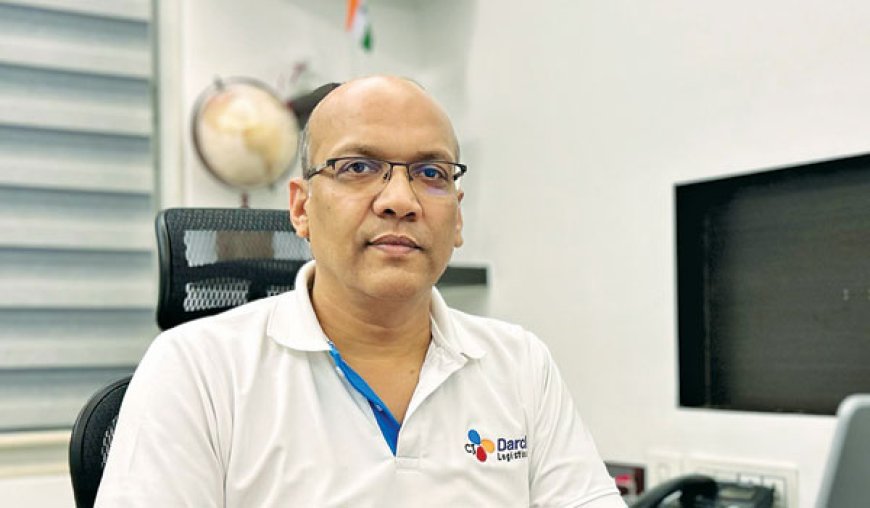We are committed to reducing our carbon footprint by shifting higher volumes from road to rail.
The Indian railway network has undergone significant modernisation and development with extended coverage of network and faster cargo movements.

How do you view the current market trend in railway freights services in India?
The Indian railway network has undergone significant modernisation and development with extended coverage of network and faster cargo movements. As per the PIB Report and current market trend, the market share of rail transportation is increasing with the government planning to take it from 35-36% (in 2024) to 45% by 2030 with the launch of strategic initiatives such as the National Rail Plan. This trend of growth is also facilitated by the integration of railways with existing infrastructure by roads, sea, ports and multimodal hubs to enhance its connectivity and lead to greater use of rail transportation.
With the surge in e-commerce, the requirement for products from across every nook and corner of the country/world has risen. To cater to this increased demand, rail logistics serves a preferred mode of transportation for long-haul deliveries across the nation. Its enhanced connectivity with first and last mile delivery systems has enabled in streamlining supply chains by reducing transit delays as well as carbon emissions.
Sustainability is another crucial trend driving the railway freight services in India. The industry is increasingly adopting solutions such as electrification of rail to reduce its carbon emissions. The electrification of rail is happening at a tremendous pace over the past decade from 1.42 km per day in 2014-15 to approximately 19.7 km per day in 2023-24. These efforts are a testament to India’s ambitious goal towards becoming the world's largest green railway with zero carbon emissions by 2030.
How is the company pushing growth in rail logistics in India?
We, at CJ Darcl, are actively working towards enhancing our operations and driving growth in our railway logistics vertical. In FY 2024-2025, we made substantial capital investments to this segment that resulted in an increase of around 79% in the total number of containers the company had in FY 2023-2024. Along with this, we also enhanced the frequency of scheduled trains, which has increased by an impressive 50% in FY 25. This enhancement in our capacity will not just help us handle larger volumes of cargo by utilizing the Indian railway network but also enable us to offer our clients a sustainable alternative to traditional road freight, contributing to their environmental goals and reducing their carbon footprint.
Apart from this, we have strategically expanded our rail routes by 30%, to ensure seamless integration of rail across our range of transportation modes. This multimodal transportation allows for efficient first and last-mile connectivity while offering a more sustainable and efficient end-to-end transportation of goods.
How has the railway infrastructure evolved for efficiency in freight services?
The government has been investing heavily in modernising the railway infrastructure of India with its multiple initiatives and plans such as:
Dedicated Freight Corridors – The launch of DFCs has been transformatory in facilitating a seamless flow of goods across the nation. It serves as a backbone for industrial and economic growth by changing the way it used to be when transportation of goods in a train would take more than 24-36 hours to reach its destination. This efficiency is demonstrated by the average speed of trains on DFCs, which stands at 58 kmph which is more than double to that of the Indian Railways' average of 23 kmph. The reliance of industries on DFCs can be reflected in the number of trains operating daily on Eastern and Western DFC, which stood at 391 in the first month of 2025.
Electrification of Railways – With the sustainable advantages of electric trains over diesel locomotives, the government has been making immense efforts to undergo 100% electrification of railways and has set a target for the completion of same by FY 26. This would empower our railway system to reduce its reliance on fossil fuels and lead to a sustainable system with enhanced operational efficiency.
Connectivity to Multimodal Logistics Parks – Over the years, the connectivity of railway terminals with multimodal logistics parks has enhanced tremendously. This has reduced the dependence on road logistics for large distances, increasing the efficiency by reducing transit times.
What are the major challenges in rail freight services in India? What is the way forward to overcome these challenges?
While the government has been actively working towards creating an advanced and well-connected logistics infrastructure to reduce the logistics cost as a percentage of GDP and enhance India’s economy, more efforts are required to address issues such as thefts, collisions & derailment of trains, terminal capacity constraint, rolling stock maintenance, oversaturated track capacity and outdated tracks. Along with these, infrastructural bottlenecks leading to uncertainty in delivery timelines is a critical factor that needs to be addressed to increase the modal share of railways to 45% as envisioned by the National Rail Plan. To create a seamless flow of goods facilitated by Indian Railways, it needs to prioritize its efforts towards upgradation and modernization of existing infrastructure, extension of Dedicated Freight Corridors across the country, expedite the installation of Kavach - Automatic Train Protection (ATP) system in trains, utilize advanced software, IoT and data analytics to optimize train scheduling and ensure better monitoring of train movements.
What are the latest innovations from the company in rail freight services in India?
As an industry leader in multimodal solutions, CJ Darcl extensively leverages the Indian Railways for freight transportation and to provide its customers the best possible solutions to their requirements, we are always on the lookout for new technologies and innovation. We have different types of containers to cater to our vast range of customers’ requirements basis the type and shape of cargo. These include high cube containers, open top containers, end open containers, dwarf height containers, tank containers, etc. All these kinds of containers serve different purposes such as transportation of volumetric cargo. We provide stockyard services at Terminals. We also provide our customers with real time GPS Tracking, monitoring and digital tracking of shipments which helps them plan their supply chain accordingly. These initiatives enable us to manage end-to-end transportation of goods, leaving our clients to focus on their core operations.
What are your future plans in the rail logistics? How do you view the market outlook in railway freight services?
At CJ Darcl Logistics Limited, we envision a future where rail logistics plays a pivotal role in building a sustainable and efficient multimodal supply chain across India. Our strategic focus is to expand rail-based offerings through enhanced infrastructure at our private sidings, and deeper integration with first-mile and last-mile services to offer end-to-end logistics solutions.
We are actively investing in technology to optimize operations — including real-time GPS tracking and automated scheduling. We also plan to increase our fleet of specialized containers, such as Dwarf containers and Coil Tainers, to cater to evolving needs in sectors like petroleum, steel, and FMCG.
Sustainability remains central to our growth strategy. We are committed to reducing our carbon footprint by shifting higher volumes from road to rail, integrating solar-powered infrastructure at our KTIG terminal, and expanding our fleet of CNG and LNG vehicles for first and last-mile connectivity.
Through strong partnerships with Indian Railways, we aim to further contribute to the government’s vision of increasing the modal share of rail in freight transport. With customer-centric innovation and operational excellence at our core, we are shaping the future of logistics.
The Indian Railways is progressing towards its flagship cargo vision ‘Mission 3000’ which envisions an increase in freight volumes to achieve a milestone of 3,000 million tonnes (mt) by 2030. The sector is undergoing advancements in a multifaceted manner driven by government’s initiatives such as National Rail Plan, strategic policy reforms enhancing regulations for freight movement along with the launch of Dedicated Freight Corridors. Along with these initiatives towards infrastructural upgrades, the government is also encouraging public-private partnership in railways. To top it all, the IR system is increasingly adopting solutions towards making the sector more sustainable and efficient. Therefore, the future outlook for railway freight services in India appears promising, and CJ Darcl, supported by a robust ecosystem of innovations and tech, is well-equipped to capitalize on the forthcoming opportunities.







